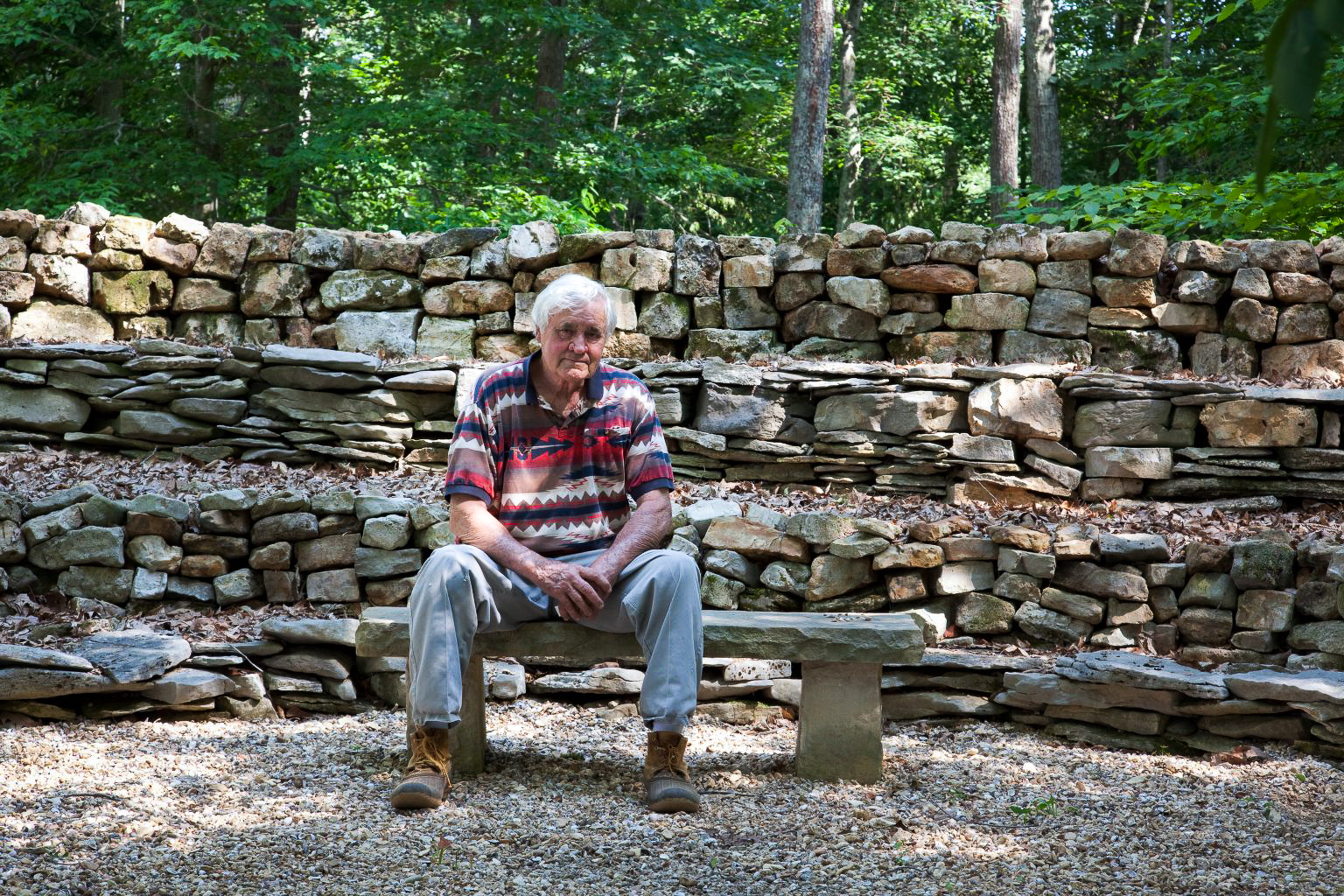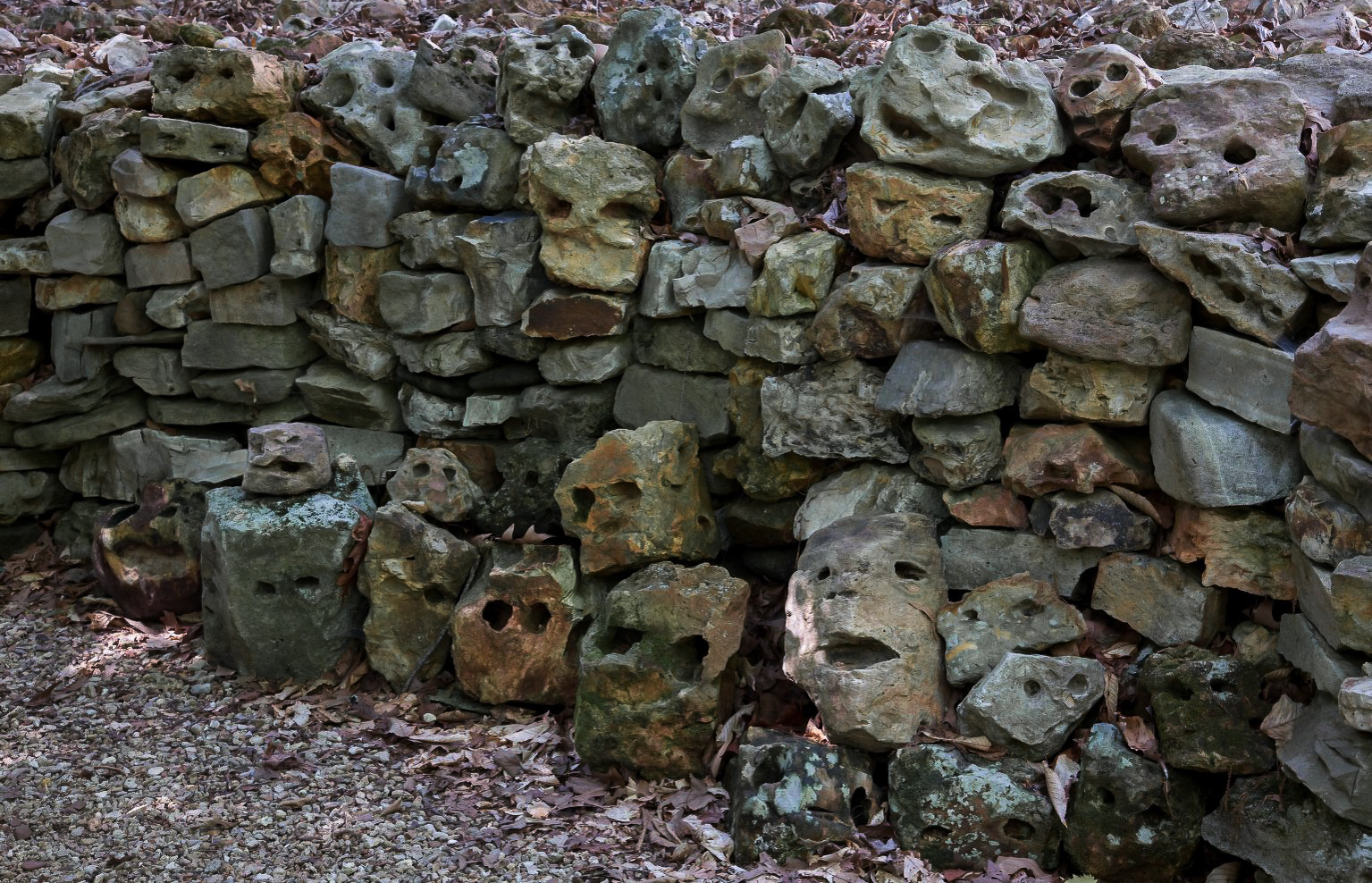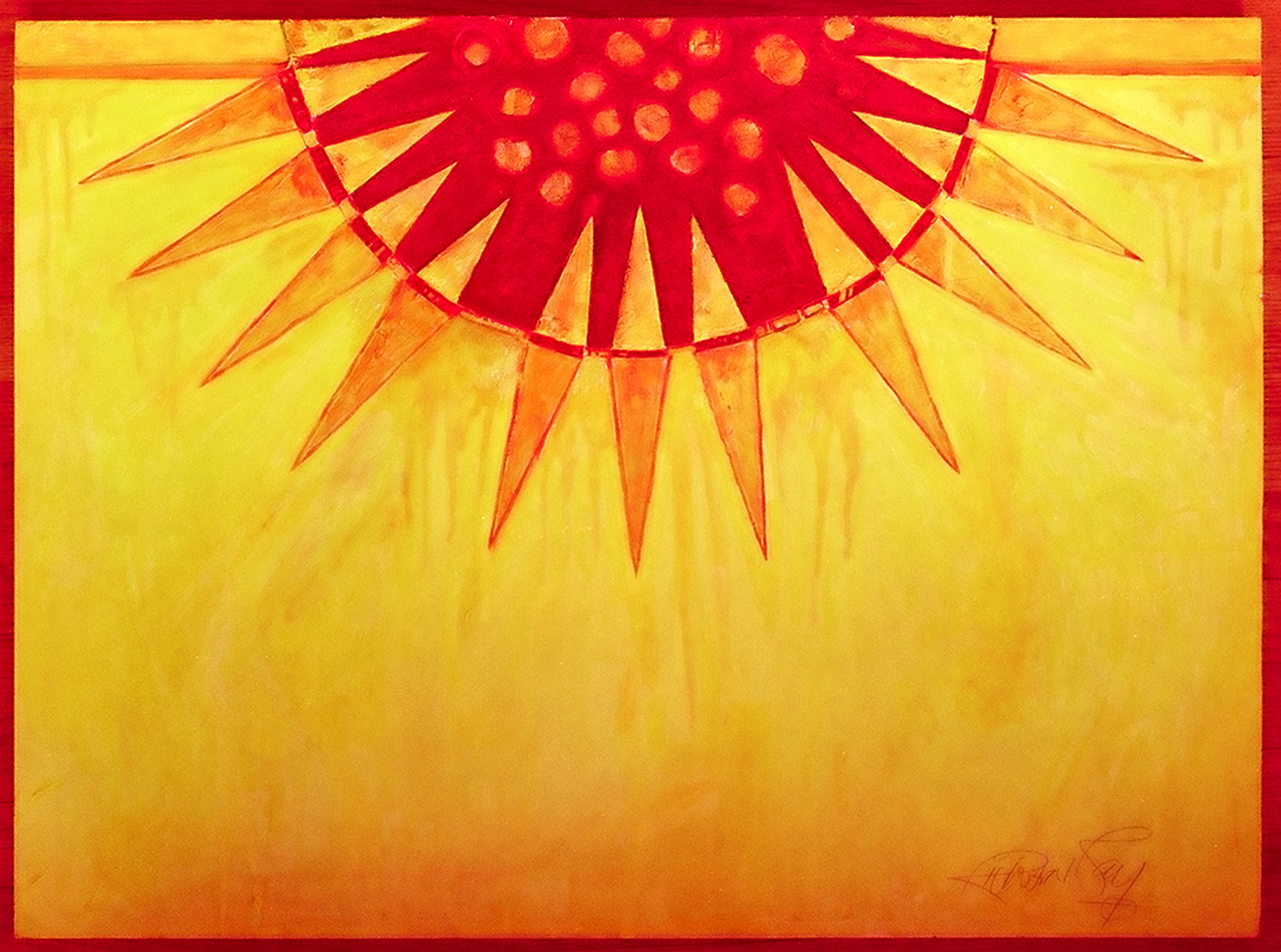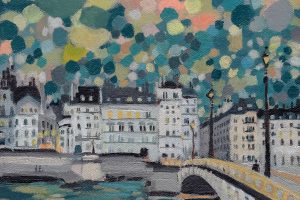Support Hidden Compass
We stand for journalism, science, history, and hope. Make a contribution to Hidden Compass and stand with us.
It’s possible to miss the wall and drive right by. In many ways it’s an extension of the landscape, as at home in its space as the dirt and the trees.
Hickories and oaks border each side of this two-lane highway I’m driving in rural northwestern Alabama, then open into cornfields whose husks and stalks bend to the breeze stirred by passing cars. A farmhouse sits back from the road, a Ford F-150 parked alongside it.
Long before the Natchez Trace Parkway connected Muscle Shoals and Nashville, and longer still before it became Nashville’s “Big Back Yard,” it served as a popular route for Native Americans. Part of their history, I later learn, is contained in this wall, which meanders along the Trace.
The stones that compose the camouflaged structure mimic the color of the dried leaves that surround it. But the way the wall rises from the ground and disappears into the trees makes me slow down and look again. The length of it — the width, the sheer extent — stops me, pulls me in.
Thirty feet thick in places, four to six feet tall, and more than a mile long, it’s the largest unmortared wall in the United States, according to the National Trust for Historic Preservation. The nine million or so pounds of stone were painstakingly laid, over 33 years, by a single man, to commemorate his great-great-grandmother’s remarkable journey — a heroic five-year trek back home in direct defiance of the federal government.
Working with hands heavily bruised and calloused, Tom loaded and unloaded his pickup truck each day, collecting, transporting, and laying every stone — alone, just as Te-lah-nay had been.
I don’t yet know why this wall is here, but I decide that I have to see it. I drive to the edge of a field and park in the grass. Crossing the road, I notice an unassuming middle-aged man leaning against the front of a dusty pickup. He has the disarming air of someone who senses that you’re coming.
There are no signs, so I approach tentatively. “This wall,” I say, “is incredible.”
The man smiles. He’s clad in khakis and a loose denim button-down, a T-shirt visible beneath; his clothes mirror his relaxed demeanor. His dark hair is gray at the temples, and his white chevron mustache rises as he smiles at me. I glimpse his name printed on his shirt: Trace Hendrix.
I introduce myself, keeping my focus on him. But I have a strong urge to look around, to see this wall that I had only glimpsed before deciding to stop. As he speaks, I soon realize that he isn’t the wall-builder. He’s the memory-keeper.
~~
“I am here to teach people about my great-great-great-grandmother Te-lah-nay’s life and journey, and why my father, Tom, chose to honor her by building this wall,” Hendrix says.
A driveway divides two sections of the structure. To the left, a five-foot-wide pathway follows the wall — a dirt footpath carpeted with leaves and shaded by oak, maple, and beech trees. As I step down the path, the wall envelops me. The Natchez Trace Parkway, only 40 feet away, is silent. The only sounds are the breeze in the trees and my own feet shuffling through dry leaves.
Examining the wall carefully, I’m struck by its sturdiness. The labor that went into building it, layer after layer after layer, must have been extraordinary.
Shadows dance off the jutting rocks as I walk. After about 10 minutes I come to the end of this pathway. As I retrace my steps, I spot a military dog tag hanging from one of the rocks. I stop myself from touching it. Hendrix said this is a place of honor, and I want to respect that.
“All things shall pass. Only the stones will remain.”
I step nimbly around the protruding rocks, noticing their irregularities, their lack of symmetry. I’ve seen only a portion of the wall’s length, but I know that Hendrix is waiting for me. He wants to tell me Te-lah-nay’s story before I continue. He wants me to understand why his father, Tom Hendrix, spent a third of a century laying this wall — the country’s largest physical memorial to a Native American woman, I later learn — stone by stone by stone.
~~
Te-lah-nay was born into the Yuchi tribe in the early 1800s. The group, which at the time numbered just over 600 people, lived peacefully in Alabama near the Tennessee River, which they called the Singing River. According to Yuchi legend, a woman lived in the water and sang to the tribe, giving the river a musical quality.
After Te-lah-nay was born, Hendrix says, her grandmother placed her umbilical cord in the water, making the river her symbolic sister. The Singing River became the soundtrack to Te-lah-nay’s life, and her strongest symbol of home. To be without it, she was later known to say, would kill her.
One day, when Te-lah-nay was playing by the river, she was struck by lightning. The event, says Hendrix, turned her brown eyes blue-gray, with shimmers of green. The color was said to be mesmerizing, and she was given the name Te-lah-nay, which means Woman With Dancing Eyes.
But as she grew into a young woman, what really drew notice was her power to heal. She learned from her grandmother, a noted healer in the tribe, and developed her intuitive understanding of which plants to blend for medicine.
One day a woman arrived with her young daughter, who was suffering from an incurable headache. Te-lah-nay peeled a strip of bark from a nearby willow tree and told the girl to chew on it while she boiled the rest down, then instructed her to drink. Before long, the girl’s pain had subsided, and the mother wept in relief.
Te-lah-nay had healed the child with the salicylic acid found in willow bark — the same ingredient that, decades later, would be used in pharmaceutical aspirin.
~~
In 1830, when Te-lah-nay was about 13 years old, President Andrew Jackson’s administration negotiated a plan to take Native Americans from their homes in the Southeast and move them west to Oklahoma, so that white men could farm the fertile land. Nearly 100,000 Indigenous people were eventually marched along the Trail of Tears, heading toward the designated Indian Territory hundreds of miles beyond the Mississippi River.
Te-lah-nay and her fellow Yuchi knew nothing of what was to come, or why. All they knew was that one day strange men in uniforms appeared. Te-lah-nay’s grandmother sent her and her sister down the river by canoe to escape capture. When Te-lah-nay returned days later, she found the makeshift graves her grandmother had created for all the family members who had been killed.
Then a second round of soldiers appeared. They spared Te-lah-nay’s life, but stripped away her identity. A string was hung around her neck; the tag attached read “59.” She was no longer the Woman With Dancing Eyes. She was now a number.
~~
Te-lah-nay and members of nearby tribes were taken from their homes and forced to walk 12 miles a day. Many wore through their moccasins and stumbled along barefoot. They had only the clothes on their backs and the few possessions they could carry. As they walked, they passed bodies and freshly dug graves.
While others around her died from disease, exhaustion, and maltreatment, the traumatized but hardy teenager survived the forced march. She soon earned a reputation as a healer among the many displaced people in Oklahoma, yet she mourned her family and yearned for her home. For a full year she tried to accept her new life, but the Singing River called to her. Her homesickness became so great that she felt she would die if she didn’t get back to the land she loved.
So Te-lah-nay formulated a plan to escape, gathering material to make a travel bag. A tribal man took note and quietly approached her, offering her a small knife for protection.
One year after her arrival in Oklahoma, Te-lah-nay disappeared. She was soon “presumed deceased.”
In reality, the Woman With Dancing Eyes was on her way home. To her real home — over 700 miles away.
~~
Nothing seemed good enough, permanent enough, to capture Te-lah-nay’s strength and keep her memory alive.
It took Te-lah-nay — a homesick and miserable teenager, walking alone — five years to cover the distance from Oklahoma to Alabama.
Hendrix described her journey as she moved stealthily though the thickest parts of the forests she could find. Trying to stay hidden in the mountains of Arkansas, he said, she frequently lost her way. The long shadows cast by the Devil’s Backbone, a portion of the Ouachita Mountains, blocked out the sun and moon, disrupting her sense of navigation.
When Te-lah-nay tried to follow rivers and streams, the giant bamboo-like canebrakes that grew in the water — and concealed russet-striped rattlesnakes — formed jungle-dense thickets that were nearly impenetrable.
To eat, says Hendrix, Te-lah-nay relied on her knowledge of plants and the hunting-and-gathering skills she’d honed as a child. In the rivers she caught fish, crayfish, and mussels. In the forests she set snares to trap small game. She’d stay for several days at a time in areas with an abundance of food, stocking up for the days when she would have none.
At one point, Hendrix says, two white men chased Te-lah-nay up a tree and threatened to rape and kill her. Leaping from a bough, she stabbed one of the men in the shoulder with the knife she’d been given in Oklahoma. Then she ran, pursued by the men’s hunting dogs. When she came to a creek she leaped into it, throwing the dogs off her scent.
Only twice in five years did strangers take her in. In both cases, says Hendrix, Te-lah-nay was offered sanctuary by a Native American woman with a white husband. One of the men was a trader and renowned marksman, who helped Te-lah-nay cross the Mississippi River, then guarded her with his guns when white men tried to purchase her.
At last, in 1837, Te-lah-nay made it home. According to some sources, she is the only Native American — and the only young woman — to have ever walked back to her home from Indian Territory.
Te-lah-nay eventually married a white man, had three children, and lived a long life just north of her original home, quietly healing whoever came to see her.
~~
Tom Hendrix heard the stories of Te-lah-nay from his grandmother, the first memorykeeper. He wanted to honor his great-great-grandmother’s journey — to create a fitting monument for someone who’d had the will and fortitude to undertake a righteous, epic journey. Nothing seemed good enough, permanent enough, to capture Te-lah-nay’s strength and keep her memory alive.
In 1986, however, when Tom was 50 years old and retired, he had a conversation with Yuchi elder Minnie Long. Te-lah-nay had apparently dictated a journal of her time in Oklahoma, and Long, who was fluent in the Yuchi language, was able to read the account. Knowing that Tom wanted to memorialize his ancestor, she said: “All things shall pass. Only the stones will remain.”
The words resonated with Tom Hendrix. What better way to symbolize Te-lah-nay’s indefatigable strength and tenacity than a wall built from the stones of her homeland?
Tom wanted each stone to represent a step his great-great-grandmother had taken on her forced march away, and on her return walk home. Each unique stone would rest on another, mirroring Te-lah-nay’s journey.
Unmortared, the wall would defy the laws of conventional engineering, just as Te-lah-nay had defied the laws of the land. Uneven, it would represent the unpredictable nature of her unguided journey. Unshakable, it would symbolize Te-lah-nay’s profound strength, her refusal to stop walking even when everything in her wanted to quit.
One stone at a time, Tom began to tell Te-lah-nay’s story. He lugged limestone, sandstone, and fieldstone he found on his own five-acre property — some in wheelbarrows, some filling the bed of his truck — to the site. Then he began the backbreaking work of placing the first layer, bending low, rising, and bending again. Once that was complete, he laid the second layer, working eight to nine hours a day.
When he had finally cleared his land of stones, he turned to his neighbors, who were happy to be rid of the rocks littering their farmland. Working with hands heavily bruised and calloused, Tom loaded and unloaded his pickup truck each day, collecting, transporting, and laying every stone — alone, just as Te-lah-nay had been on her long walk home.
Year after year he continued — eventually sourcing stones from a local bluff — and the wall he created curved and weaved and welcomed.

Builder of the Wichahpi Commemorative Stone Wall, Tom Hendrix, rests on a bench surrounded by his handiwork — the end product of 33 years of toil. Photo: Carol M. Highsmith/Library of Congress.
~~
One day, about 15 years into Tom’s labor, with about half a mile of wall constructed, the chief of the Lakota people (who was also that group’s head medicine man) arrived, curious to see the great-great-grandson of a heroic Yuchi woman. He seemed to understand and respect Tom’s vision, and especially admired the fact that Tom, whose mother was white, was so determined to tell his Native American ancestor’s story.
Tom felt honored by the chief’s interest. As a tribal elder and the main medicine man of his people, the chief was revered. Tom felt compelled to do what the man asked of him.
“I can feel the spirituality in this wall,” the chief said. “But with your permission, I’m going to make it more spiritual. I’d like to make some additions to the wall, something only a full-blood can witness.”
So one day, while Tom waited in the family house that sat farther back on the property, the chief embedded medicine bottles between layers of stone. Tom understood that they represented both Te-lah-nay’s talents as a medical healer and the healing place that this wall would become.
Another day, the chief brought along his nephews to add rocks with natural variations — holes and grooves that made each stone look like a face. The nephews stacked the stones under the chief’s direction, creating a wall of faces.
“These faces represent Te-lah-nay’s ancestors — the grandparents who passed down stories that taught lessons and values,” the chief told Tom. “They made Te-lah-nay who she was, and without them, this wall would have been incomplete.”

In this section of the wall, natural variations in the rocks form faces — the visages of Te-lah-nay’s ancestors. They represent her ancestors. Photo: Carol M. Highsmith/Library of Congress.
Sometimes the chief’s direction made no sense to Tom. When Tom created an east-facing prayer circle, per the chief’s specifications, the chief shook his head and said, “It’s not right. Tear it down, and do it again.”
Tom was tired. He was nearly 70 years old at that point and had been laboring for nearly 20 years. But, out of respect for the chief, he obeyed. He thought he would have to redo the prayer circle once or twice, and the chief would be satisfied. But month after month, the chief returned to survey the circle, and month after month, he shook his head and told Tom to start over. Six visits. Six times Tom dismantled and rebuilt the circle.
Finally, on the seventh visit, the chief studied the circle, nodded, and said, “I think you’ve got it right this time.”
At last — after 33 years, nine million pounds of stone, and three pickup trucks — Tom was ready to rest. He was 83 years old, and his wall was over a mile long.
Tom died on February 20, 2017, having placed stones till the very end of his life. He’d always told his son, Trace, stories about Te-lah-nay and urged him to “make these stories your own, and do it to honor your ancestors.”
~~
He’s the memory keeper.
Trace Hendrix pauses his story and nods toward the path I’ve just walked. “That side of the wall represents Te-lah-nay’s forced removal from the only home she knew,” he says.
It makes sense. That pathway is shorter than the one I’m about to explore. And with more protruding rocks, it’s a visual representation of the compounding misery of walking farther away from her home with every step.
This path is shaded and dark, and as I reflect on that, I look to the wall to my right. I’m struck by the contrast. There, dappled sunlight dots the stones, forming a random but beautiful mosaic. This part of the wall represents Te-lah-nay’s journey home — her journey to freedom.
Just a few steps down the pathway, I see the wall of faces — of frozen stares. Some have no hole for a mouth. Some have protrusions exactly where a nose would be. Some holes are askew, creating a sneer. The largest, most prominent face is perched on the ground, with smaller faces stacked upon it. Its mouth hole is large, and its chin protrudes downward, so that it appears to be surprised — as caught off guard by me as I am by it. “Wow!” it seems to say, as I mouth the word.
It’s how I feel as I walk the wall. It meanders and curves, yielding to old trees in its path, curving around their firm roots. Small, intimate nooks form in the curvature of the walls, inviting two or three people to sit on the rough stone benches placed at intervals and reflect not only on Te-lah-nay’s journey but on their own as well — on whatever it was that brought them here.
As I walk along this path I feel a sense of peace. Nature often has that effect on me, but this is more profound. It borders on spiritual.
This wall, ironically, breaks down the barriers of time and cultural differences. It unites a young woman from the 1830s with people many generations later — people like myself, who are curious enough about the stone wall to pause in our own journeys.
~~
Unmortared, the wall would defy the laws of conventional engineering, just as Te-lah-nay had defied the laws of the land. Uneven, it would represent the unpredictable nature of her unguided journey. Unshakable, it would symbolize Te-lah-nay’s profound strength, her refusal to stop walking even when everything in her wanted to quit.
Emerging from the path, I notice for the first time the prayer circle. The chief had eventually explained to Tom that the seven circles he’d built represented the seven generations between Te-lah-nay’s great-great-grandparents and her own great-great-grandchildren — those who had brought her into the world, and those who had committed to keeping her memory alive.
I walk toward it, taking in its size. A good 30 feet across, the circle reflects the rest of the wall — all stacked stone, but this time divided into four tiers. Hendrix tells me that they represent birth, life, death, and rebirth.
People frequently describe a feeling of euphoria after walking the wall, he says. One said it made the hair on his arms stand up. Another, a 90-year-old woman, comes here every month to walk barefoot on the wall. She says it makes her feel better.
The wall especially draws veterans. “We get a lot of men and women suffering from PTSD,” Hendrix says. “One, who had done three tours in Vietnam, said this was the only place he ever found that gave him some peace, a break from his trauma. That man carried a rock from the South China Sea to Alabama so he could contribute to the wall.”
In fact, the wall today contains stones and artifacts from all 50 states and 139 countries, territories, and islands. A petrified turtle, a meteorite, a brontosaurus bone, a piece of iron pyrite, a massive arrowhead, and a rock from a steam vent in Mount Vesuvius are all there too, next to the prayer circle, sent by people from all over the world.
Most walls are meant to divide, to keep us out or away from one another. But the Wichahpi Commemorative Stone Wall, as this structure is now officially known, unites. It calls out to us to stop, to hear a story about a woman we’ll never meet but whom we’re likely to remember forever.
It invites us all to absorb her strength. It invites us all to be memory-keepers.

Telling the origin story of the Yuchi people, this painting by renowned Yuchi artist Richard Ray Whitman conceptualizes the blood of the sun. According to Yuchi legend, the light of the sun represents the emergence of the Yuchi into the world. The sun here is sacrificial: She spills her own blood to ensure a prosperous future for her people. Painting: Richard Ray Whitman, Blood of the Sun, mixed media collage on masonite, 24” x 32”.
Rebecca Deurlein
Rebecca spent the first half of her life writing for others; now she's pursuing her own passions and strengthening her own voice. A freelancer based in Houston, Rebecca loves to discover new places and new people, then delve into the stories that make them so interesting.
Never miss a story
Subscribe for new issue alerts.
By submitting this form, you consent to receive updates from Hidden Compass regarding new issues and other ongoing promotions such as workshop opportunities. Please refer to our Privacy Policy for more information.



